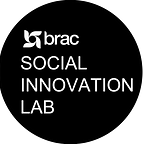Suggestion, not prescription: what can an experiment with pharmacies tell us about hygiene uptake
As the world continues to fight against the ever evolving COVID-19 pandemic, it has become imperative to encourage compliance to hygiene behaviours, to enable people to stay safe. With support from the FCDO-Unilever funded Hygiene and Behaviour Change Coalition (HBCC), BRAC’s Social Innovation Lab (SIL) has tested a number of approaches across Bangladesh to generate evidence on what works best to make hygiene habits stick. Did they work? Here’s what we found out!
Recognising the Highest Source of Impact
Across the country informal health providers like village doctors, pharmacists/chemists, etc. are often the first point of healthcare for communities, and hold tremendous influence over their clientele when it comes to health information and advice. We recognised that presents a prime opportunity to affect health and hygiene behavior by disseminating messages via a trusted source. To that end, we prototyped and tested out a series of “nudges” that leverage pharmacies and medicine shops, to understand contextual barriers to mainstreaming hygiene habits of: (a) hand hygiene, (b) mask use and respiratory hygiene, and (c ) social distancing.
Designing with a Purpose
At a time when information clutter was high and compliance was slow, designing the right nudges with the right messages got tricky. One of our key design drivers focused on making our nudges more noticeable, and attention-grabbing.
We ended up prototyping 5 nudges at pharmacies across contexts:
a. ribbons with decals indicating the standing positions for customers to encourage social distancing as they wait in line
b. provide guidelines on proper mask usage along with the mask inside a printed envelope so that a wearer sees the message just before putting on the mask.
c. posters for pharmacists to give to customers about recommended behaviours
d. print hygiene messages on the packets/envelopes in which customers carry their purchased medicines home so that they are exposed to the message at the right time
e. behavior reinforcement messages painted on mirrors that are placed strategically on opposing sides of the counter at the pharmacy.
Innovation that Works
Of the 5 prototypes tested, 3 were found to be viable for scaling. For small purchases, as is usually the case for the majority of transactions in rural medicine shops, the pharmacists generally hand out items in a small paper envelope. During the design phase, we assumed based on our own experiences, that this envelope receives a person’s attention at two points in time- firstly on receiving the envelope and secondly on extracting the items from the envelope. Two of our nudge designs leveraged these existing consumer behaviors to try and provide relevant, timely messages, the results for both appearing quite positive. We collected clear evidence that among the majority of those who read the instructions on the mask envelopes, wore the mask correctly. 84% of the respondents seemed to wear the mask correctly.
Message recall of the medicine envelopes also saw a high percentage with compliance behaviour posters seeming to help with information retention as well. Based on the results of these prototypes, it appears that medicine envelopes are a great way to disseminate important information and nudge desired behaviors through pharmacies, medicine shops, and shops in general. If coupled with innovative or divergent message formats that are likely to be memorable, and bold artwork that draws the eye, we may be able to ensure that the messages capture attention!
Why Some Nudges Didn’t Work in Context
While the viability of the mirror messaging nudge remains inconclusive, the ribbons with decals prototype provided some interesting insights on why the design seemed to have failed. Reports suggested that most customers ignored the messaging of social distancing, as some continued to lean in over the ribbons. During rush hours, customers became agitated when asked to maintain distance. Consequently, this discouraged the pharmacists to continue pursuing this prototype — fearing loss and dissatisfaction of customers. Conversations with the pharmacists revealed that social distancing was maintained well during the first 6 months of the lockdown. This was mainly because of strict and proactive mandates by law enforcers. However, as the lockdown eased and lifted, the general public seemed to grow more reluctant to adhere to these rules.
Is Nudge Prototyping the Key to an Additional Push for Sustained Impact?
It’s evident that there are approaches that work to encourage adherence to safe hygiene behaviours. Drawing from the ones that work, as well as the ones that don’t can help build on scaling up what works best in context. While you may wonder that there’s no guaranteed large-scale impact especially in a changing climate, what helps is contextually testing relevant and innovative nudge designs.
Why nudge? Because in a space where there’s a clutter of information with seemingly low levels of willingness to comply, that extra push may encourage people to adopt the recommended hygiene practices and help in the reduction of COVID-19 transmission.
This article was authored by our colleagues Ahmed Abu Bakr, Rubayat Khan and Archi Ananya from Jeeon.
